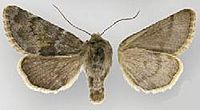Lasionycta luteola facts for kids
Quick facts for kids Lasionycta luteola |
|
|---|---|
 |
|
| Scientific classification | |
| Kingdom: | |
| Phylum: | |
| Subphylum: | |
| Class: | |
| Order: | |
| Family: | |
| Genus: |
Lasionycta
|
| Species: |
L. luteola
|
| Binomial name | |
| Lasionycta luteola (Smith, 1893)
|
|
| Synonyms | |
|
|
The Lasionycta luteola is a fascinating type of moth. It is part of a big family of moths called Noctuidae. This moth lives in the cooler, northern parts of North America.
Contents
All About the Lasionycta luteola Moth
The Lasionycta luteola moth was first described by Smith in 1893. It is a small but interesting insect that plays a role in its mountain home. Like all moths, it goes through a life cycle of egg, larva (caterpillar), pupa, and adult.
Where This Moth Lives
You can find the Lasionycta luteola moth in specific areas of North America. It lives from northern Washington and southwestern Alberta. Its range extends northward into southwestern Yukon.
This moth prefers a special kind of environment called the alpine tundra. Alpine tundra is a cold, treeless area found on high mountains. It is above the treeline, where trees cannot grow because of the harsh conditions.
What This Moth Does
Adult Lasionycta luteola moths are mostly active at night. This means they are nocturnal. However, they also fly around during the day. This makes them a bit unusual compared to many other moths.
When they are flying, these moths look for food. They enjoy drinking nectar from flowers. One of their favorite flowers is Silene acaulis, which is also known as moss campion. This plant often grows in the same cold, rocky places where the moth lives.
How It Looks and When It Flies
The Lasionycta luteola moth has a wingspan of about 27 millimeters. This is roughly the length of a small paperclip. Its wings are usually a yellowish color, which is how it got its name "luteola," meaning yellowish.
You can usually spot these moths flying for a short time each year. They are on the wing from the middle of July to the middle of August. This short flight period is typical for insects that live in cold, high-altitude places.
See also
 In Spanish: Lasionycta luteola para niños
In Spanish: Lasionycta luteola para niños

